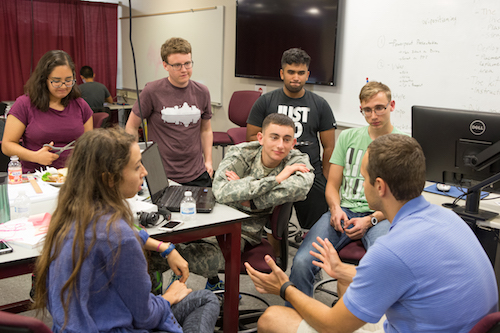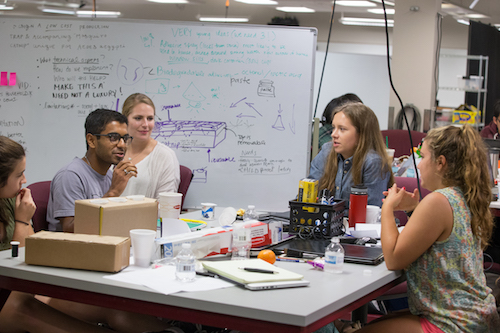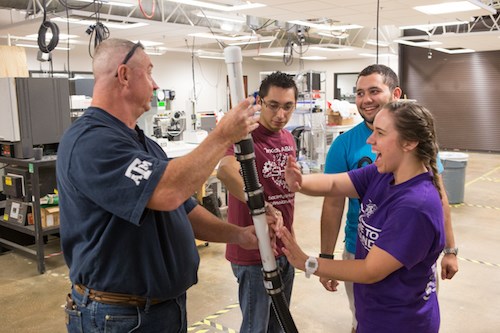
When 80 motivated and innovative students from five universities work together, novel ideas will emerge. The first [U] Invent produced 12 solutions to combat the spread of the Zika virus through educational and conceptual solutions. More than $4,000 in award funds and an opportunity for two students from a winning team to meet with the Centers for Disease Control and Prevention (CDC) was presented to the students.
Innovate Against Zika is the first [U] Invent program implementing the highly successful Aggies Invent model which gives students 48 hours to collaborate in teams solving identified design challenges related to a specific topic. The students have complete access to the Engineering Innovation Center (EIC) and topic experts throughout the innovation competition.

“It was great having other universities participate in the first [U] Invent,” said Rodney Boehm, associate professor of practice. “All of the students blended into tight teams and it allowed us to show how we innovate at Texas A&M University.”
The Texas A&M University College of Engineering and The Zika Foundation partnered to host Innovate Against Zika with the goal of applying new discoveries about the Zika mosquito using trans-discipline expertise to halt the spread of the Zika virus through the rapid development and implementation of low-cost, sustainable solutions. Student teams chose from one of three tracks for their needs statement: vector (mosquito) control, immune households or community resiliency and sustainability.
“This weekend opened my eyes to the ability for people to pull themselves together for a common cause,” said Garrett Harmon. “It’s really motivating to me to think more about my education and what I’m doing now so I can have a great effect of people in the future.”
Innovate Against Zika was stacked with 20 of the brightest researchers in the fields of public health, entomology, chemistry, architecture, engineering and biotechnology to guide and advise the students throughout the weekend. Some of the mentors and presenters included Dr. R. Ulrich Bernier, the acting national program leader and research chemist with the USDA’s Agricultural Research Service, whose efforts are focused on surveillance and control of the vector(s) responsible for pathogen transmission; Dr. Michael Callahan, a physician scientist board certified in internal medicine, infectious disease, tropical medicine (DTM&H) and mass casualty care and a clinical and research faculty member at Massachusetts General Hospital/Harvard Medical School; and Josue Young, a researcher in the Medical Entomology Department at the Gorgas Memorial Institute in Panama City, Panama.

“Control of Zika is a problem-rich issue,” said Callahan. “We therefore are compelled to bring this challenge to a solution-rich setting where new answers can be identified. This is the first time engineers, architects and urban planners have been given complete access to Zika-mosquito experts. We believe this event has identified new solutions to this growing global problem.”
The first-place team, awarded $1,000, was SWATeam. The team developed an app that engages young people in games to find mosquito areas, provides education and allows the community to learn more about Zika. The team consisted of two Texas A&M students — Kendra Mack, from biomedical sciences and Ankita Brahmaroutu from the college of medicine — and five University of Texas students —Jason He, electrical engineering; Annabel Wang, Ishani Chakravarty, and Justin Zhong, chemical engineering; and Zhra Biabani, economics.
The Bucket List team took second place and was awarded $750. This team developed a Zika protection kit that is contained in a mosquito trap to form a multi-dimensional solution. The members of this team included Kedar Balakrishna, Diego Garcia, Austin Lu, Liana Polikaitis and Ashley Tucker, biomedical engineering; Jessica Lee, biomedical science; and Megan Rodriguez, nuclear engineering.
The third-place team, awarded $500, developed an education program in a pictogram that would be attached to rain barrels currently being distributed by non-governmental organizations worldwide. The Persistent Pictogram team consisted of three Texas A&M students, Mo Adesanmi, chemical engineering, Clare Elizondo, biomedical science and Jane Frederick, biomedical engineering; two Wichita State University students, Hannah Hund, biomedical engineering and LaRissa Lawrie, strategic communications; and Stephanie Strong, chemistry and biology from East Carolina University.
In addition to the top three teams receiving award money, The Texas A&M University System awarded $200 to each of the remaining nine teams due to their high quality and innovative designs. All teams are encouraged to continue developing their prototypes and business models for implementation or distribution.

The CDC showed its interest in Innovate Against Zika by offering to bring two members from the winning team to Atlanta to present the team’s innovation to the Zika response team, speak with its technology transfer experts and tour its insectary.
“It’s been really great to have such a wide variety of mentors available and bringing them all together allows us to learn about the whole picture and not just one niche of the research,” said Strong. “I was excited to come here and be a part of the solution. This has been a life changing experience.”